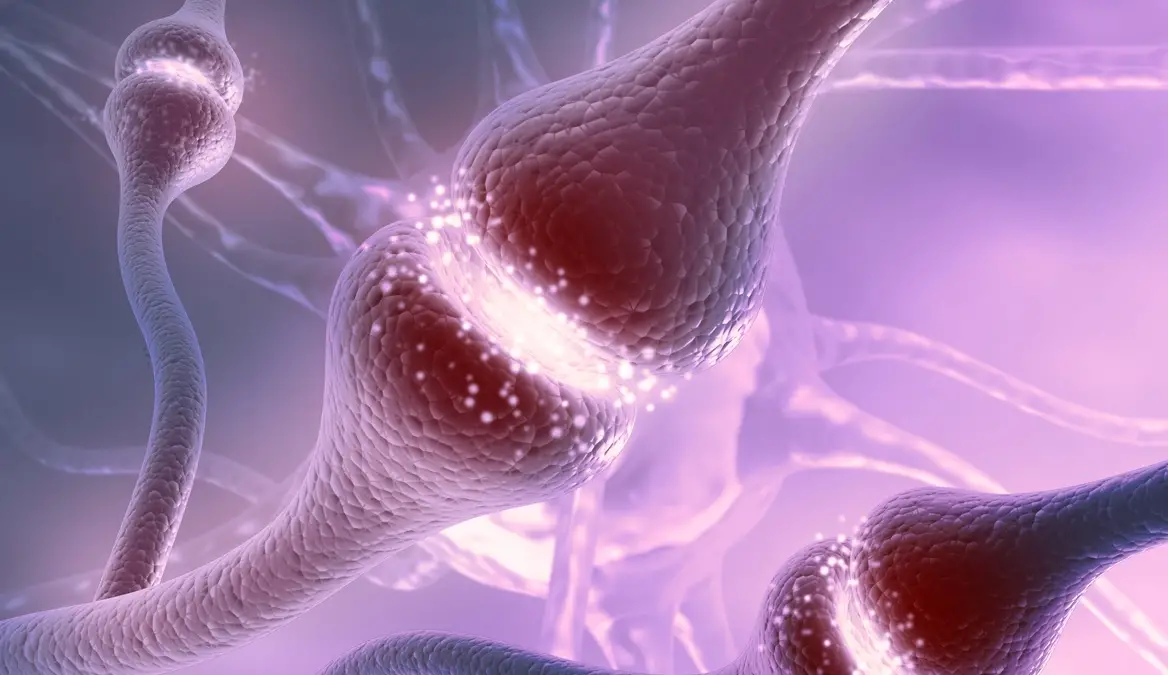Neurotransmitter
 Graphics courtesy of MidCity TMSOpens in new window
Graphics courtesy of MidCity TMSOpens in new window
|
Neurotransmitters (also referred to as neuromodulators) are chemicals in the body that convey messages between neurons (nerve cells).
- Types of neurotransmitters include monoamines, amino acids, and peptides.
- The major monoamines include dopamine, serotonin (5-HT), norepinephrine (noradrenaline), epinephrine (adrenaline), acetylcholine, and melatonin.
- Amino acids include gamma-aminobutyric acid (GABA), glutamate, aspartate, and glycine. Other neurotransmitters are adenosine and histamine.
In 1904, British scientist T.R. Elliott found that the substance extracted from the adrenal glands (adrenaline) mimicked actions of the sympathetic nervous system (SNS).
The SNSOpens in new window is responsible for regulating the fight-or-flight responseOpens in new window, including increased heartbeat, blood pressure, and perspiration.
In 1914, British physiologist Sir Henry Halett Dale (1865 – 1968) investigated the active substance in ergot, a fungal infection of wheat or rye.
Ergot has strong effects on the central nervous system, including death. Dale found that the active substance in ergot (later chemically identified as acetylcholine) would reverse the effects of adrenaline (Sabbatini, 2003).
In the 1920s, Otto Loewi, a professor of physiology in Vienna, Austria, did an experiment with two frog hearts. Stimulating a nerve on one frog heart resulted in inhibition of the heartbeat. When he infused the second frog heart with material from the first, the second heart showed a similar effect. He was able to demonstrate that a substance (later identified as acetylcholine) was responsible for the inhibiting effects on the heartbeat. He used a similar technique to demonstrate the effects of adrenaline as an excitatory (stimulating) substance.
In research conducted in the 1920s and 1930s, Sir Henry Dale demonstrated that neurotransmitters could also act in the voluntary nervous system. For their work clarifying the role of neurotransmitters, Loewi and Dale shared the Nobel Prize in 1936 (Sabbatini, 2003). The catecholamines (dopamine, norepinephrine, and epinephrine) were studied in the 1950s and 1960s.
Swedish researcher UlfVon Euler and American researcher Julius Axelrod received the 1970 Nobel Prize for their work identifying and studying the metabolism of norepinephrine (Sabbatini, 2003).
Amino acids have been studed since the 1960s (Gordon, 2000). Several peptides studied in the 1970s—Substance P, leucine, and methionine-enkephalin—were all found to be involved in the sensation of pain (Gordon, 2000).
Neurotransmitter receptors alter cellular excitability. Some neurotransmitters are primarily inhibitory (e.g., GABA and glycine), others are primarily excitatory (e.g., L-glutamate), and others may serve multiple functions (both inhibitory and excitatory).
An excitatory neurotransmitter increases the probability that a target receptor cell (neuron) will activate (fire), while an inhibitory one decreases this probability.
Neurotransmitters transmit signals by binding to specific receptor cells. For example, the neurotransmitter dopamine (DA) only binds to DA receptors. After a neurotransmitter is released into the synapse (a tiny space between cells), it may bind to a receptor, be destroyed by enzymes, or be reabsorbed by the neuron. The reabsorption mechanism is known as a reuptake transporter pump.
Through reabsorption, some neurotransmitters are recycled so that they can be used over and over (Preston, O’Neal, & Talaga, 2008). Neurons continuously manufacture new neurotransmitters to replenish those lost through enzymatic degradation.
Some neurotransmitters have been linked with certain functions. For example:
- Acetylcholine has been implicated with memory.
- Dopamine is associated with reward and addiction. Addictive drugs (e.g., cocaine, heroin, methamphetamine) primarily affect the dopamine system.
- Endorphins are associated with pain.
- Norepinephrine is linked with memory and the fight-or-flight response.
- Melatonin is associated with circadian rhythms and the body’s biological clock, and
- Serotonin is associated with mood and aggression.
Some psychiatric medications make use of the reuptake transporter system to block specific neurotransmitter receptors. Drugs that block reuptake make more of the neurotransmitter available for use in the synapse.
Antidepressant medications such as selective serotonin reuptake inhibitors (SSRIs) block serotonin reuptake. Antipsychotic medications that block dopamine receptors are used to treat schizophrenia. Benzodiazepines (such as Valium) prescribed to treat anxiety bind to specific sites in GABA receptors.
The functions and effects of neurotransmitters depend on the location of receptor neurons, interconnections with other neurons, and interactions among brain and body regions.
Factors and relationships are often complex; often several neurotransmitters and interactions among multiple brain regions influence human behavior, cognition, and emotion. As research continues to shed light on these relationships, new medications are being developed to increase treatment effectiveness and decrease side effects.
- Gordon, E. (2000). Integrative neuroscience: Bringing together biological, psychological and clinical models of the human brain. Boca Raton, FL: CRC Press.
- Preston, J.D., O’Neal, J.H., & Talaga, M.C. (2008). Handbook of clinical psychopharmacology for therapists (5th ed.). Oakladn, CA: New Harbinger.
- Sabbatini, R.M.E. (2003, April – July). Neurons and synapses. The history of discovery.

